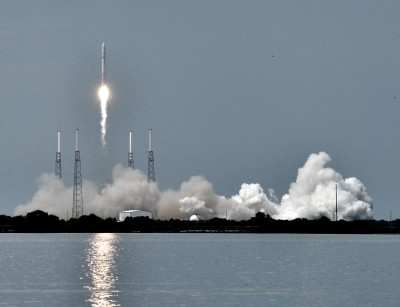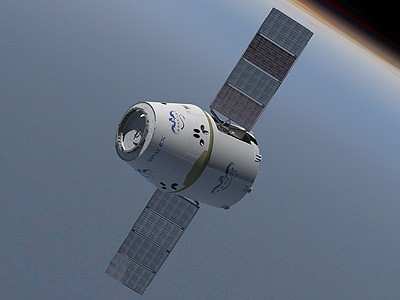COTS Demonstrations Now Set For Feb 7 Liftoff
NASA has announced the launch target for Space Exploration
Technologies' (SpaceX) second Commercial Orbital Transportation
Services (COTS) demonstration flight will be February 7, 2012.
Pending completion of final safety reviews, testing and
verification, NASA also has agreed to allow SpaceX to send its
Dragon spacecraft to rendezvous with the International Space
Station (ISS) in a single flight.
Falcon 9 Launch

"SpaceX has made incredible progress over the last several
months preparing Dragon for its mission to the space station," said
William Gerstenmaier, NASA's associate administrator for the Human
Exploration and Operations Mission Directorate. "We look forward to
a successful mission, which will open up a new era in commercial
cargo delivery for this international orbiting laboratory."
Gerstenmaier said, "There is still a significant amount of
critical work to be completed before launch, but the teams have a
sound plan to complete it and are prepared for unexpected
challenges. As with all launches, we will adjust the launch date as
needed to gain sufficient understanding of test and analysis
results to ensure safety and mission success."
During the flight, Dragon will conduct a series of check-out
procedures that will test and prove its systems in advance of the
rendezvous with the station. The primary objectives for the flight
include a fly-by of the space station at a distance of
approximately two miles to validate the operation of sensors and
flight systems necessary for a safe rendezvous and approach. The
spacecraft also will demonstrate the capability to abort the
rendezvous, if required.
Dragon will perform the final approach to the ISS while the
station crew grapples the vehicle with the station's robotic arm.
The capsule will be berthed to the Earth-facing side of the Harmony
node. At the end of the mission, the crew will reverse the process,
detaching Dragon from the station for its return to Earth and
splashdown in the Pacific off the coast of California. If the
rendezvous and attachment to the station are not successful, SpaceX
will complete a third demonstration flight in order to achieve
these objectives as originally planned.
SpaceX Dragon Artist's Concept

"SpaceX is on the forefront of demonstrating how a partnership
between the government and private industry can lead to new
capabilities and provide a large return on investment," said Alan
Lindenmoyer, program manager for COTS at NASA's Johnson Space
Center in Houston.
"SpaceX is excited to be the first commercial company in history
to berth with the International Space Station. This mission will
mark a historic milestone in the future of spaceflight," said
SpaceX President Gwynne Shotwell. "We appreciate NASA's continued
support and their partnership in this process."
Begun in 2006, NASA's COTS program is investing financial and
technical resources to stimulate efforts within the private sector
to develop and demonstrate safe, reliable and cost-effective space
transportation capabilities. In a multiphase strategy, the program
is spurring the innovation and development of new spacecraft and
launch vehicles from commercial industry, creating a new system of
delivering cargo to low-Earth orbit and the International Space
Station.
Through Space Act Agreements, SpaceX will receive up to $396
million and Orbital Sciences Corp., NASA's other COTS partner, will
receive up to $288 million for the successful completion of all
milestones in the agreements. To date, SpaceX has received $376
million for completing 36 out of 40 milestones and Orbital has
received $261.5 million for completing 23 out of 29 milestones.
 ANN's Daily Aero-Linx (04.16.24)
ANN's Daily Aero-Linx (04.16.24) Aero-News: Quote of the Day (04.16.24)
Aero-News: Quote of the Day (04.16.24) Airborne 04.10.24: SnF24!, A50 Heritage Reveal, HeliCycle!, Montaer MC-01
Airborne 04.10.24: SnF24!, A50 Heritage Reveal, HeliCycle!, Montaer MC-01 Airborne 04.12.24: SnF24!, G100UL Is Here, Holy Micro, Plane Tags
Airborne 04.12.24: SnF24!, G100UL Is Here, Holy Micro, Plane Tags Airborne-Flight Training 04.17.24: Feds Need Controllers, Spirit Delay, Redbird
Airborne-Flight Training 04.17.24: Feds Need Controllers, Spirit Delay, Redbird




